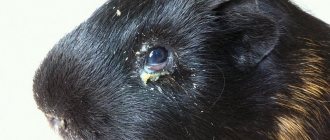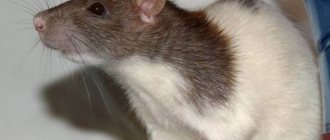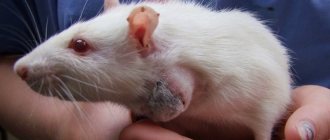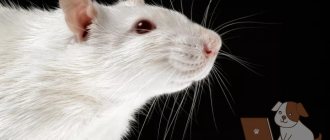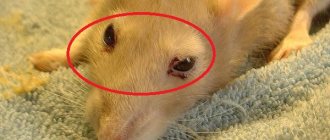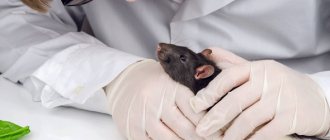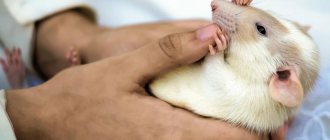Small pets get sick quite often. If a rabbit, guinea pig or rat has inflammation from wounds or scratching, then you should carefully examine the affected area and apply local treatment. If treated incorrectly, the site after a bite can lead to decay and death of the animal due to the occurrence of a secondary infection.
Symptoms
- Swellings with purulent contents form on the skin.
- The skin at the site of the abscess becomes thinner and peeling is noted;
- The animal refuses to eat, its behavior changes - the animal loses activity and does not show interest in anything.
Invaded bacteria and infections begin to actively grow, which is why a “capsule” is formed around the abscess itself, which prevents the spread of pathogenic bacteria to neighboring tissues.
Hyperemic (reddened) segments may appear on the skin, which subsequently become denser; the last stage of development of the disease is the formation of an abscess with purulent contents, this place is soft to the touch.
An abscess can develop in different ways:
- if the animal’s immunity is strong enough, the body is able to overcome the formation of pus and destroys all bacteria and infections inside the capsule;
- the formation of an abscess above the level of the skin, and not inside the tissues, as a result of which the thinned skin is opened, the purulent contents come out and healing occurs;
- an abscess forms inside the tissues, spreading inward, nearby vessels carry pathogenic bacteria throughout the body, and sepsis develops.
Causes of an abscess
An abscess is a purulent disease that occurs in various tissues, organs, muscles and bones. It can be internal and external.
The causes of an abscess on the body of a decorative rat include:
- bites;
- scratches;
- wounds;
- other causes of damage to the integrity of the skin.
Dangerous bacteria penetrate into an open wound, causing an inflammatory process, as a result of which the animal’s immunity decreases and pus accumulates.
Important! The owner of a pet can also infect it with staphylococcus found on human skin.
Localization
An abscess can occur on absolutely any part of the animal’s body:
- oral cavity – bring severe discomfort, disrupting the usual way of life, and are marked by severe pain;
- groin - in males;
- head - ears, neck;
- body – sides, limbs, belly, withers;
- eyes - formation in this place may indicate the presence of tumors on the brain, as well as a rapid decrease in immunity.
On the neck
The location of the abscess in this place is very dangerous, and opening it is permissible only in a hospital setting, because the abscess is located near the passage of large vessels and lymph nodes. Ignoring an abscess in this place is fraught with the rapid development of sepsis.
A tumor that arises in this place can be either benign or malignant, so the doctor makes the decision on what to do best to save the life of the animal after collecting the puncture and on the basis of histological and cytological examination of the contents of the tumor.
In addition to abscesses located in the neck, tumors located in the mouth and near the eyes should also be observed by a doctor. Self-treatment in these cases is unacceptable.
Where can it occur
The occurrence of an abscess on the body of a rat is fraught with various consequences. The purulent contents of the capsule can break out both outside (mild course of the disease) and inside the body (severe course). The location of the malicious source is also important.
Did you know? The rat's teeth are so strong that they can chew through concrete and iron.
An abscess appears in the following places:
- in the oral cavity near the roots of the teeth;
- on the neck;
- behind the ears;
- on the limbs;
- on the stomach;
- on the sides;
- in males in the groin area;
- behind the eyes.
The most dangerous are the ulcers formed on the animal’s head.
Treatment of abscesses in rats
The main treatment for such abscesses is surgical opening. The operation is performed under local anesthesia. The wound is opened to remove pus, then washed using antiseptic solutions. Postoperative care involves the use of antibiotics and ointments to relieve inflammation and pain. If the abscess was deep in the tissue, which required a deep incision, sutures will be placed, in which case postoperative care includes further treatment of the sutures with antiseptics.
Types of abscesses
Abscesses are collections of pus found in different parts of the body. The causes of abscesses are:
- internal (caused by other diseases)
- superficial
However, no matter what the abscess is, if left untreated for a long time or if it is not treated correctly, it can lead to serious illness in the animal. The bacteria that infects rodents can spread throughout the body and become fatal. It can enter the bloodstream and poison it, leading to death without prompt, effective medical attention. But if treatment is started at the first sign of an abscess, then the chances of recovery are very high.
Opening an abscess at home
If the abscess has formed in other areas and is small in size, opening and treating it at home is acceptable.
It is important to know that only a mature abscess can be opened! To speed up the process of “maturation” of the tumor, an iodine mesh is applied to the affected area.
The following symptoms will help you understand that the abscess is ripe:
- the skin at the site of the tumor and around is hyperemic;
- the middle of the tumor changed its color to light and became soft.
To open an abscess at home you must:
- Wash your hands thoroughly with soap.
- Remove hair from the area where the outbreak is located.
- If a crust has formed on the tumor, it is soaked in warm water for further removal with a cotton pad.
- It is necessary to press down on the base of the tumor, the pressure should not be strong and sharp, and should also be applied towards the top of the hole, in order to avoid pus from entering the internal tissues.
- It is necessary to completely clear the cavity of pus; the escaping pus, along with lymph, must be removed with a cotton pad.
- Next, you need to rinse the cavity. You need to fill the syringe with chlorhexidine (1%) + betadine (diluted with water in a ratio of 1:5) + 9% saline solution. The wound is washed with this solution.
- It is necessary to blot the wound with clean gauze/napkin (preferably sterile).
- Levomekol or analogues are applied to the wound.
Main features
A timely detected subcutaneous abscess on a rodent's body will help save the life of a pet.
This disease can be recognized by the following signs:
- the rat’s behavior changes - it becomes lethargic, sleepy, and inactive;
- First, at the site of abscess formation, the skin turns red, later swelling occurs;
- the skin on the abscess becomes thinner and becomes covered with scabs;
- When opened, the resulting inflamed capsule is filled with yellow or green pus, emitting a rotten smell.
Further care
After the autopsy, daily treatment of the wound with antiseptic solutions and ointment is necessary; in addition, experts recommend a course of antibiotic therapy (prescribed by a veterinarian).
You also need:
- taking probiotics – to restore microflora after antibiotics;
- isolation of a sick pet from other animals;
- place a small bottle of warm water in the cage as a heating pad for a small patient;
- temporarily make filler from soft paper or napkins, and clean the home daily;
- The diet of a sick animal must be balanced; it is possible that the animal will drink more than usual; make sure that there is plenty of water.
Aftercare
Opening an abscess for a decorative rat is a serious operation that requires further care for the animal’s rapid recovery.
It is as follows:
- antiseptics can be used no more than once a day;
- isolate the sick rodent from other pets;
- provide him with adequate nutrition and plenty of fluids to restore strength, and also introduce probiotics into the diet to normalize the intestinal microflora after taking antibiotics;
- clean the cage with the rat every day, avoiding any unpleasant odor in it.
Also learn how to identify and treat mycoplasmosis in a rat.
Prevention measures
If you want the best for your pet, it's best to simply not let bacteria get to them. It is necessary to remove dirt and discarded pieces of food from the cage, as they are sources of bacteria. Disinfect your rodent's home once a week or more often (depending on how many animals live in the cage). Use soft bedding that does not contain anything sharp and remove all rough, rough, and sharp objects from the cage. Cover wire floors with some durable material and give your pet only clean, fresh food. It is also advisable to disinfect the drinking bowl every 2-3 days.
If for some reason your rodent has a wound on its body, then treat it well with some antiseptic solution until it heals. If you do not allow the wound to fester, then the possibility of an abscess is excluded.
How does an abscess form?
An abscess is a focal purulent inflammation of tissue. Internal abscesses are localized in various organs and tissues in serious infectious diseases: abscesses of the lungs and liver. External abscesses form on the animal’s body as a result of a violation of the integrity of the skin (scratches, wounds, bites), the penetration of normal microflora into various organs and tissues against the background of inflammatory diseases and decreased immunity.
IMPORTANT!!! The owner himself can infect his pet with staphylococci, which constantly live on human skin.
Subcutaneous abscesses are characterized by:
- the formation of a painful swelling filled with pus;
- thinning of the skin in the center of the abscess, scabs at the site of tissue damage;
- deep damage or general infection of the body may be accompanied by refusal of food, lethargy, and inactivity.
An inflammatory process caused by the proliferation of staphylococci and streptococci develops in the damaged tissue. Around the source of inflammation, lymphocytes form a kind of capsule that prevents the penetration of pathogenic bacteria into healthy tissues. An abscess begins with redness of the rodent's skin, then the affected area thickens, at the end of the process an abscess is formed with soft green or yellow pus inside. Pus is an accumulation of dead lymphocytes, pathogenic microbes and blood cells. The color, consistency and smell of pus can be completely different and depend on the type of pathogenic microflora.
The development of an abscess can go in different ways:
- the purulent contents are destroyed by the body inside the pyogenic capsule, recovery occurs;
- a bulge with pus is formed, which comes out at the site of thinning of the skin, the wound heals and the abscess goes away;
- a convex subcutaneous abscess breaks through, pathogenic microflora penetrates through the bloodstream into healthy organs and tissues, causing inflammation and sepsis;
- the abscess grows deep into the tissue, which is also fraught with septic shock and death.
Treatment
If your rat's abscess is small, you can wait until it breaks out on its own and then treat the wound with an antiseptic. If a serious abscess is detected, it is best to contact a veterinarian. Removing an abscess is a minor operation that is performed with or without anesthesia, depending on how severe the inflammation is and where it is located on the animal's body. Removal is performed with a scalpel, and then treated with an anti-purulent medicine. If the abscess is large, stitches may be needed. Bandages are not used as they block airflow to the wound, which can slow down the healing process. Most often, the animal needs to be given (or injected) with antibiotics for some time to be sure that the disease does not get worse.
Abscesses in the rat's head area, especially behind the eyes, are very dangerous. This means that the rat's immune system has been destroyed or that the rat has a brain tumor. In both cases, death is inevitable.
Abscesses around the roots of a rat's teeth are very difficult to remove and cause a lot of pain to the rat. Pus can be squeezed out from the bottom of the teeth to relieve pressure or a head that has formed in the skin under the rat's jaw can be cut out. Abscesses behind the eyes most often form at the same time as abscesses under the teeth, and are the worst of all rat infections. Due to their inaccessibility, they cannot be removed and must be treated from the inside. The rat needs to be given antibiotics by mouth or injection, but in any case, abscesses behind the eyes indicate a brain tumor.
Respiratory diseases in rats and mice
One of the most common reasons for visiting a veterinary clinic with rats and mice is respiratory diseases.
In eighty percent of cases, there are complaints of heavy breathing, wheezing, sniffling, and discharge from the nasal passages. In addition, respiratory pathologies are detected in half of the cases of visits to the clinic for other reasons.
There are a number of infections of bacterial, viral or fungal etiology that can cause respiratory tract diseases in mouse-like rodents.
Mycoplasmosis in rodents
The main pathogen for rats and mice is Mycoplasma pulmonis, which causes chronic respiratory syndrome, many of the symptoms of which do not appear suddenly, but increase with age of the animal.
This happens as follows. You buy a small pet, he is cheerful and active, has an excellent appetite, gains weight well and does not show any signs of illness. Then your pet grows and sometimes you begin to notice that he sniffles in his sleep, during an intense walk or while eating. Sometimes you hear sneezing, after which the animal washes itself more thoroughly, and you can observe a “rusty coating” on the fur in the muzzle area. At the same time, appetite and activity do not change. After some more time, your pet becomes less active, shortness of breath is noted - the sides are heaving heavily, and there is constantly dried discharge around the eyes and nose. Weight loss is observed. And after some time, the animal begins to open its mouth when breathing, the mucous membranes acquire a pale or bluish tint, the pet rapidly loses weight, and moves little. Such changes can occur over a period of several weeks to several months. And the sooner you seek help from a veterinary clinic, the greater the chance that your pet will live a long and comfortable life.
Signs of mycoplasmosis
So, the clinical signs of mycoplasmosis may vary depending on the location of the process and the stage of the disease.
If the upper respiratory tract is affected, sneezing, snoring, discharge from the nose and eyes may be present; the rat often rubs its nose with its paws, the fur around the eyes and nose is stained with porphyrin. As the disease progresses, the infection spreads to the lower respiratory tract, where it can cause bronchitis and bronchopneumonia. Auscultation can detect “rumbling” wet sounds when breathing. The corresponding symptoms are: cough, shortness of breath, weight loss, apathy, change in color of the mucous membranes.
In addition to respiratory symptoms, mycoplasmosis in rats and mice is often accompanied by the appearance of scratching on the skin, and in females the reproductive tract is also affected (bleeding or purulent discharge from the genitals). Mycoplasmosis also causes otitis media, signs of which may include discharge from the external auditory canal, tilting of the head, loss of orientation in space - the animal “walks in circles.”
Mycoplasmosis infection
Infection with mycoplasmosis can occur in several ways: from a female to her offspring, through sexual contact, or by airborne droplets. Infection is facilitated by weakened immunity, crowded housing, and poor ventilation of the habitat. According to existing data, Mycoplasma pulmonis is not a pathogen for humans and other non-mouse-like rodents. However, it is very common and contagious among mice and rats.
Treatment of mycoplasmosis in rats and mice
As mentioned above, mycoplasmosis in rats occurs in a chronic form, and unfortunately, there are no drugs that can completely cure this disease. As a rule, therapeutic treatment is aimed at suppressing the infectious process to improve the quality of life and its duration. From the moment the first signs of mycoplasmosis appear, the animal can live for many months; a properly selected course of treatment plays a very important role in this.
To suppress symptoms, only certain antibiotics are successfully used, and in especially severe cases, their combinations. One of the features of mycoplasmas is the absence of a cell wall; this determines their resistance (resistance) to certain groups of antibiotics. Therefore, not every drug in the medicine cabinet will help overcome the disease. The choice of antibiotic, dosage and duration of the course are selected based on the age of the animal, stage of the disease, the presence of concomitant pathologies and a number of other reasons. Often, in order to prescribe effective treatment, in addition to examination and auscultation, a number of additional studies are required, which include radiography and laboratory diagnostics.
In the final stages of the disease, if indicated, in addition to antibiotics, the use of glucocorticoids, diuretics and bronchodilators may be required.
In cases of severe shortness of breath, an oxygen chamber is indicated for the animal until the condition stabilizes, so it is useful for owners of such animals to always have an oxygen canister on hand, which is sold in pharmacies.
Oxygen chamber for rodents at home: an oxygen tank is connected to a plastic box or carrier using a rubber tube (the side holes in the carrier can be sealed with tape to ensure a higher concentration of oxygen):
To prevent disturbances in the gastrointestinal tract due to long-term antibiotic therapy, in some cases I recommend drugs that normalize the microflora. In addition, it is possible to correct the feeding diet, because Animals require more energy to maintain the vitality of the body and fight infection, so easily digestible and nutritious foods should be included in the diet.
Sometimes having a humidifier and regular irrigation of the mucous membranes of the nasal passages, for example with AquaMaris spray, also helps to make breathing easier.
Animal owners must remember that under no circumstances should they interrupt the prescribed course of treatment at the first signs of relief, and also change the dosage of the prescribed medications! You should not independently select medications for treatment, since an incorrectly selected drug or its dosage will not only not help your pet feel better, but can also lead to retardation in growth and development in young animals, abortion in pregnant females, and death in older animals .Strict adherence to the specialist’s recommendations will help prolong your pet’s life and make it as comfortable as possible.
When purchasing new animals and intending to place them with other pets, it is necessary to observe quarantine for at least 3-4 weeks.
Mycoplasmosis makes the body of rats and mice more susceptible to secondary bacterial infections (causative agents Streptococcus pneumoniae, Corynebacterium kutscheri, Pasteurella pneumotropica, Pneumocystis carinii, etc.). They can cause both independent diseases (for example, pneumonia, lung abscesses) and occur in combination with mycoplasmosis, which greatly complicates the animal’s condition. Unlike mycoplasmosis, which is chronic, these infections most often occur acutely, and if you do not contact a specialist in a timely manner, the prognosis is extremely unfavorable.
Lung abscess in a rat
Tumors in rodents
Besides infectious diseases, there are also a number of other reasons why your rat or mouse may be sneezing, coughing, or having difficulty breathing.
Rats and mice are prone to developing tumors. Sometimes the cause of difficulty breathing can be a tumor in the lungs or metastases. Unfortunately, it is impossible to prevent this process, but if it is detected in a timely manner (the most effective and accessible method is radiography), the animal can breathe easier and create more comfortable conditions for life in general. There are several regimens that are used for cancer, they include the use of drugs that inhibit the growth of cancer cells, drugs that make breathing easier, as well as oxygen therapy, a special diet high in nutrients, etc.
Radiography is one of the available and effective methods for making a diagnosis:
Lung tumors in rats
Heart diseases
Heart disease can also cause heavy breathing. For diagnosis, auscultation (listening) of the heart, radiography, and ultrasound of the chest are used. Under the supervision of a specialist, most heart pathologies can be controlled through therapeutic treatment, and the animal may not show signs of shortness of breath for a long time and feel well.
Pulmonary edema in a rat with heart failure:
Prevention of diseases in rodents
Speaking about respiratory diseases, we should also mention such a provoking factor as the environment. The correct choice of bedding plays a vital role here.
It is quite logical that the litter needs to be changed in a timely manner - this is the prevention of many diseases, not only respiratory ones. If the animal is kept in a terrarium or a dune-type cage, the filler should be changed more often than in a lattice cage, due to poorer air ventilation.
Now about what kind of filler should be used in mice or rats.
In almost all cases where wood granular filler is used as bedding, sooner or later the rodents will develop respiratory problems. This is not to say that this filler is so bad, it just should be used for other animals. For example, the cats for whom it is intended do not sit in their litter box all day long, but come to it for a couple of minutes a day. Rodents spend almost all their time on the litter; it gets wet from urine, then dries, and after running on it, the animal inhales tiny particles that cause irritation of the mucous membranes. Then a response appears - the animal sneezes. Subsequently, this leads to severe inflammation of the upper respiratory tract, rhinitis, and it becomes difficult for the animal to breathe.
Currently, pet stores offer a wide range of fillers for keeping mouse-like rodents. Corn filler has proven itself best, as it perfectly absorbs moisture, absorbs odors, does not generate dust and does not require very frequent replacement. An alternative is cellulose rodent litter. Don't try to replace it with toilet paper or napkins - they are not the same thing!
Dry air in the house can also provoke sneezing and nasal discharge. First of all, this applies to the autumn-winter period, when heating devices are turned on in the apartment, windows are rarely opened, the air becomes dry and contributes to irritation of the mucous membranes of the respiratory tract. Ventilate the premises in a timely manner and control air humidity. The air humidity in the room where rodents are kept should not be lower than 40%.
There should be no strong odors in rooms where rodents are kept. Do not use air fresheners, scented candles, or other items with irritating odors near cages.
© 2012 Tishkina Svetlana Vladimirovna
Vkontakte
